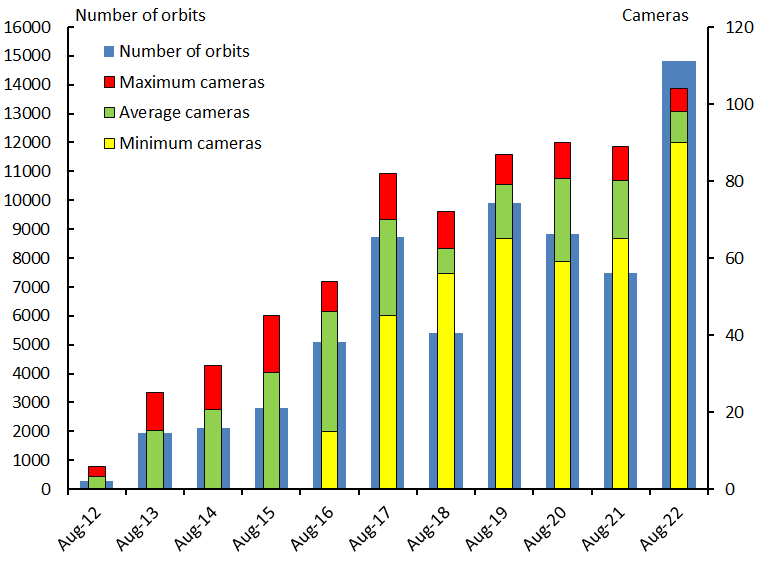Carl Johannink
A summary of the activity of the CAMS BeNeLux network during the month of August 2022 is presented. This month we collected a total of 57530 multi-station meteors resulting in 14807 orbits.
1 Introduction
August remains the favorite observing month for many amateurs. Especially around August 12 many observers try to observe one of the great showers on the northern hemisphere, the Perseids. Moon wise, the circumstances for meteor observing were bad: Full Moon coincidences nearly exact with the period of the greatest meteor activity. Another aspect that could hamper observations is off course the weather. But this year, that would not be a big problem.
2 August 2022 statistics
The weather in August 2022 was dominated by high pressure over western Europe. Cloudy and rainy weather was nearly absent. As a result, we could collect many meteors simultaneously in every night: in 27 nights the number of orbits was above 100. In 12 nights, the number of orbits exceeded 500 and in 2 nights even more than 1000 orbits were collected. In every night we obtained at least dozens of orbits. During the maximum activity of the Perseids on August 12–13 we could collect 1803 orbits, despite the Full Moon.

Figure 1 – Comparing August 2022 to previous months of August in the CAMS BeNeLux history. The blue bars represent the number of orbits, the red bars the maximum number of cameras capturing in a single night, the green bar the average number of cameras capturing per night and the yellow bar the minimum number.
The number of orbits this month reached 14807. Nearly 50% more than the highest August number up to then (Figure 1 and Table 1). As said, the very stable weather made this result possible. But another aspect should be mentioned here. Most nights were clear for all stations, from northern France up to the North Sea. The normal decline in the number of clear nights we see in the climate data of our regions, when looking from the southern parts to the northern parts of the BeNeLux, remained absent.
As another aspect of the favorable conditions this month, we see that at least 90 cameras were active every night. This number can be compared with the highest number of active cameras in all previous years (Table 2). In this month a maximum of 104 cameras were active in one or more nights. The mean value of active cameras was 98.1 (Figure 1).
These high numbers are also a result of some new cameras that were added to our network (Pierre-Yves Péchart at Hagnicourt, northern France and Jim Rowe at Eastbourne, Great Brittan), and, fortunately, there were only very few technical problems at most stations.
Table 1 – August 2022 compared to previous months of August.
|
Year |
Nights |
Orbits |
Stations |
Max. Cams |
Min. Cams |
Mean Cams |
|
2012 |
21 |
283 |
5 |
6 |
– |
3.2 |
|
2013 |
27 |
1960 |
13 |
25 |
– |
15.3 |
|
2014 |
28 |
2102 |
14 |
32 |
– |
20.8 |
|
2015 |
25 |
2821 |
15 |
45 |
– |
30.4 |
|
2016 |
30 |
5102 |
20 |
54 |
15 |
46.2 |
|
2017 |
28 |
8738 |
21 |
82 |
45 |
69.9 |
|
2018 |
30 |
5403 |
19 |
72 |
56 |
62.4 |
|
2019 |
29 |
9916 |
23 |
87 |
65 |
79.0 |
|
2020 |
31 |
8845 |
24 |
90 |
59 |
80.6 |
|
2021 |
29 |
7496 |
27 |
89 |
65 |
80.2 |
|
2022 |
31 |
14807 |
31 |
104 |
90 |
98.1 |
|
Total |
309 |
67473 |
|
|
|
|
3 A new meteor shower on August 16?
On August 16, 2022, the global CAMS low-light videocamera networks detected an outburst from a mean radiant in the anti-helion source. This new shower was called the 18-Aquariids (Jenniskens, 2022a). The shower was detected first mainly by the networks in the USA and Chile, but when all data was available from our stations, we could add 17 members of this shower which turned out to be the August delta Capricornids stream (#199 ADC) (Jenniskens, 2022b).
According to Jenniskens there were two peaks in activity. The first peak at August 16 ~08h40m UT, not visible for our network. A second peak, a bit stronger, appeared at August 16 ~22h00m UT (Jenniskens, 2022b). It was during this peak that our network collected 17 members of this meteoroid stream on August 16, 20h00m–23h45m UT. The radiant of these meteors was very compact. The spread in right ascension in our data was ~1.5 degree (lowest value for α = 324.2 deg; highest value for α = 325.8 deg). The spread in declination in our data was ~ 1 degree (lowest value for δ = –11.7 deg; highest value for δ = –10.6 deg). For the mean values of the geocentric radiant and the orbital elements of these 17 meteors, see Table 2. These results are in good agreement with values found by Jenniskens and Roggemans (Jenniskens, 2022c; 2022d; Roggemans et al., 2022).
Table 2 – Geocentric radiant and orbital elements of 17 August delta Capricornids (ADC#199).
|
|
CAMS BeNeLux |
GMN |
|
α (°) |
325.3 |
325.3 ± 0.4 |
|
δ (°) |
–11.34 |
–11.5 ± 0.4 |
|
vg (km/s) |
24.07 |
23.9 ± 0.3 |
|
Hb (km) |
97.2 |
98.1 ± 2.6 |
|
He (km) |
86.0 |
84.0 ± 4.2 |
|
λ–λʘ (°) |
180.1 |
180.04 ± 0.35 |
|
β (°) |
+2.39 |
+2.28 ± 0.45 |
|
a (AU) |
3.02 |
2.91 ± 0.15 |
|
q (AU) |
0.549 |
0.551 ± 0.005 |
|
e |
0.817 |
0.811 ± 0.01 |
|
i (°) |
1.96 |
1.81 ± 0.36 |
|
ω (°) |
270.9 |
270.9 ± 0.7 |
|
Ω (°) |
143.80 |
143.75 ± 0.18 |
|
Π (°) |
54.7 |
54.6 ± 0.7 |
|
N |
17 |
123 |
4 Conclusion
Results in August 2022 are by far the best during 11 years of the CAMS BeNeLux project.
Acknowledgment
Many thanks to all operators of cameras in the CAMS BeNeLux network for their work and quick delivery of data. During this month the CAMS BeNeLux network kept active by the following volunteers:
Hans Betlem (Woold, Netherlands, CAMS 3071, 3072 and 3073), Jean-Marie Biets (Wilderen, Belgium, CAMS 379, 380, 381 and 382), Ludger Boergerding (Holdorf, Germany, RMS 3801), Günther Boerjan (Assenede, Belgium, RMS 3823), Martin Breukers (Hengelo, Netherlands, CAMS 320, 321, 322, 323, 324, 325, 326 and 327, RMS 319, 328 and 329), Seppe Canonaco (Genk, RMS 3818 and 3819), Pierre de Ponthiere (Lesve, Belgium, RMS 3816 and 3826), Bart Dessoy (Zoersel, Belgium, CAMS 397, 398, 804, 805, 806, 3888 and RMS 3827), Tammo Jan Dijkema (Dwingeloo, Netherlands, RMS 3199), Isabelle Ansseau, Jean-Paul Dumoulin, Dominique Guiot and Christian Walin (Grapfontaine, Belgium, CAMS 814 and 815, RMS 3814 and 3817), Uwe Glässner (Langenfeld, Germany, RMS 3800), Luc Gobin (Mechelen, Belgium, CAMS 3890, 3891, 3892 and 3893), Tioga Gulon (Nancy, France, CAMS 3900 and 3901), Robert Haas (Alphen aan de Rijn, Netherlands, CAMS 3160, 3161, 3162, 3163, 3164, 3165, 3166 and 3167), Robert Haas (Burlage, Germany, RMS 3803 and 3804), Robert Haas (Texel, Netherlands, CAMS 810, 811, 812 and 813), Kees Habraken (Kattendijke, Netherlands, RMS 378), Klaas Jobse (Oostkapelle, Netherlands, CAMS 3030, 3031, 3032, 3033, 3034, 3035, 3036 and 3037), Carl Johannink (Gronau, Germany, CAMS 3100, 3101, 3102, 3103, 3104 and 3105), Reinhard Kühn (Flatzby, Germany, RMS 3802), Hervé Lamy (Dourbes, Belgium, CAMS 394 and 395, RMS 3825), Hervé Lamy (Humain, Belgium, CAMS 816, RMS 3821), Hervé Lamy (Ukkel, Belgium, CAMS 393), Koen Miskotte (Ermelo, Netherlands, CAMS 3051, 3052, 3053 and 3054), Jos Nijland (Terschelling, Netherlands, CAMS 841, 842 and 844), Pierre-Yves Péchart (Hagnicourt, France, RMS 3902 and 3903), Tim Polfliet (Gent, Belgium, CAMS 396, RMS 3820), Steve Rau (Oostende, Belgium, RMS 3822), Steve Rau (Zillebeke, Belgium, CAMS 3850 and 3852, RMS 3851 and 3853), Paul and Adriana Roggemans (Mechelen, Belgium, RMS 3830 and 3831, CAMS 3832, 3833, 3834, 3835, 3836 and 3837), Jim Rowe (Eastbourne, Great Brittan, RMS 3829), Hans Schremmer (Niederkruechten, Germany, CAMS 803), Erwin van Ballegoij (Heesh, Netherlands CAMS 3148 and 3149).
References
Jenniskens P. (2022a). “18-Aquariid meteor shower 2022”. CBET 5159, published 2022, August 17. Ed.: D. W.E. Green. Cambridge: Central Bureau for Astronomical Telegrams.
Jenniskens P. (2022b). “August delta Capricornids meteor shower”. CBET 5161, published 2022, August 26. Ed.: D. W. E. Green. Cambridge: Central Bureau for Astronomical Telegrams.
Jenniskens P. (2022c). “Ongoing outburst from a new radiant on Aquarius/Capricorn border”. eMetN, 7, 304–305.
Jenniskens P. (2022d). “August delta Capricornids meteor shower 2022”. eMetN, 7, 306.
Roggemans P., Šegon D., Vida D., Greaves J., Sekiguchi S., Angelsky A. and Davydov A. (2022). “Near anti-helion meteor shower outburst recorded by Global Meteor Network”. eMetN, 7, 293–301.





